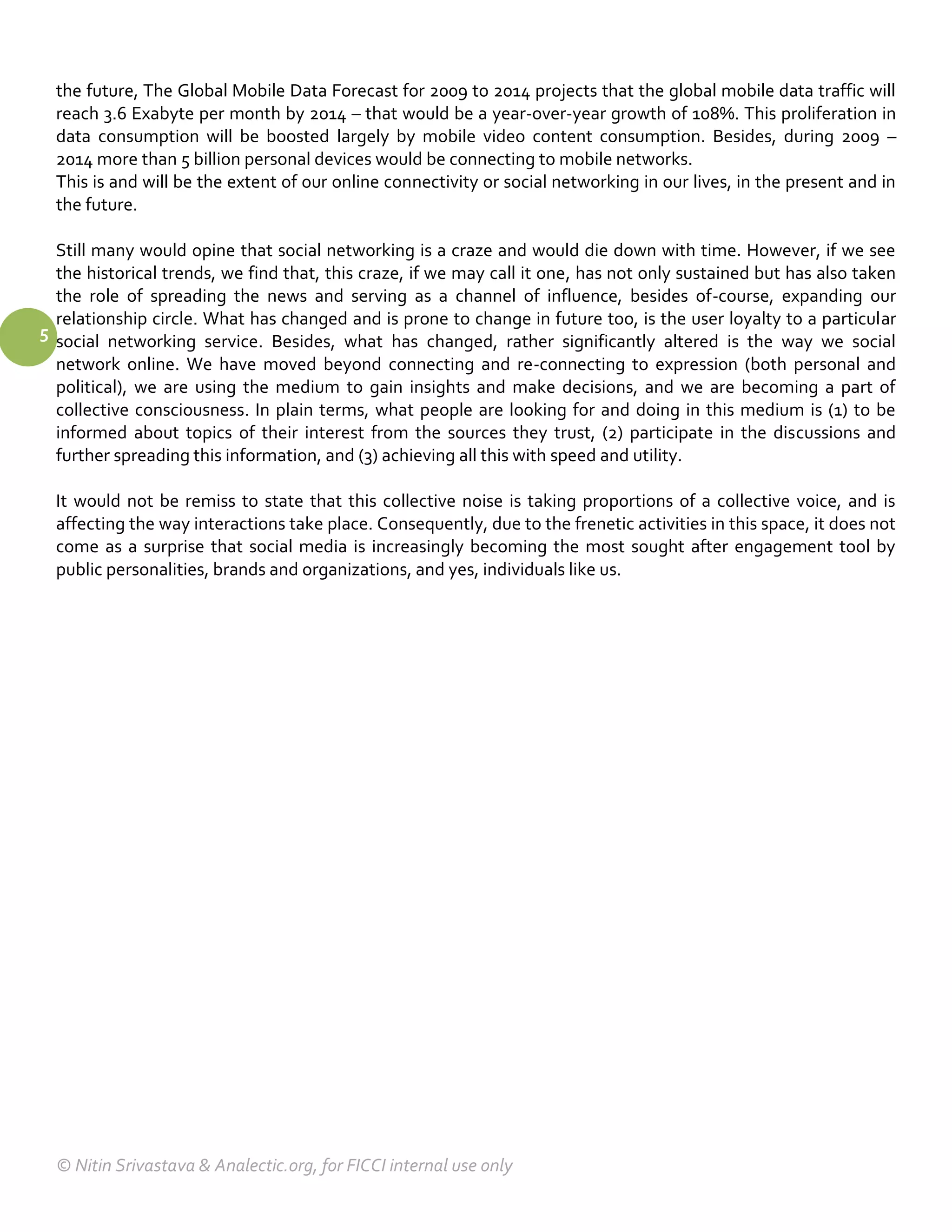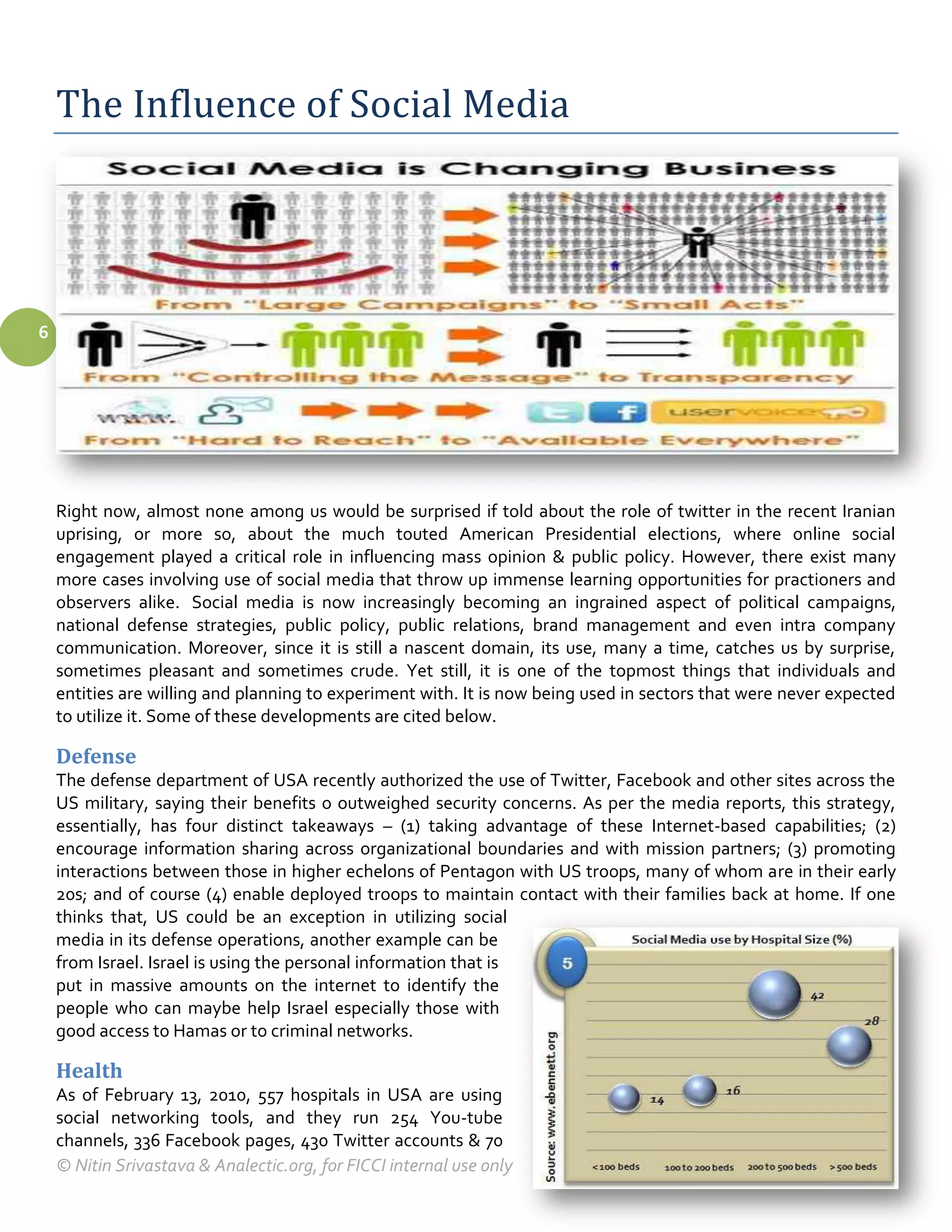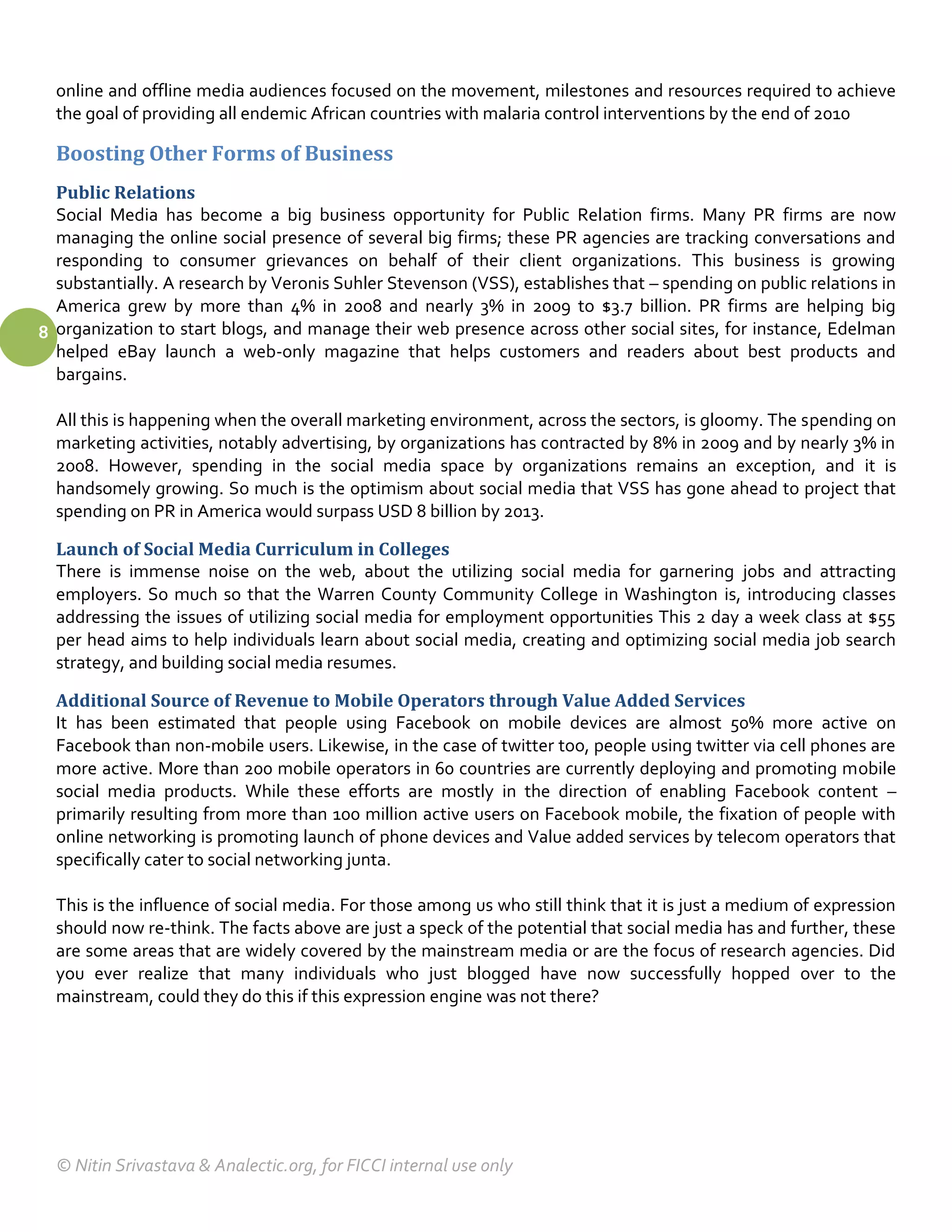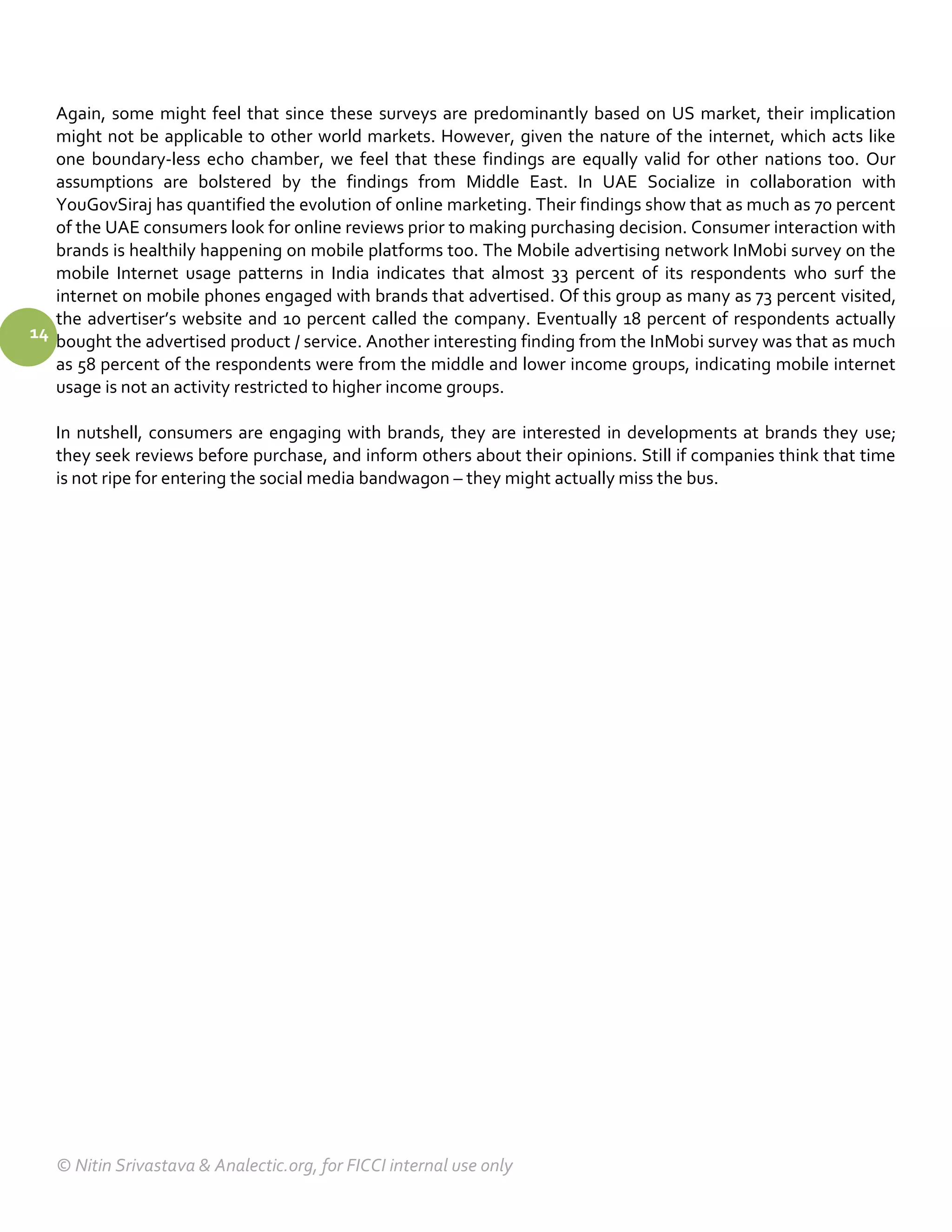Social media has become deeply ingrained in our lives and influences many aspects of communication and business. Statistics show that social networking sites could soon have more users than India's population, and people spend around 6 hours per month on social platforms. Social media is now used across various sectors for tasks like public policy, marketing, health outreach, and more. It has become an important tool for public figures, organizations, and individuals to engage with audiences.

![Quantifying Social Media
2
Online Social Networking has come a long way since it began in mid 1980s. It all started in 1985 with The Well
or The Whole Earth ‘Lectronic Link – as a generalized online community. Many would not know that the
underpinnings of Electronic Frontier Foundation could be traced to its forums. In addition, so will the roots of
Craigslist. It still has more than 4000 members who dissect issues ranging from the gravest to downright silly.
Now defunct Geocities followed the Well in 1994. Geocities hosted around 38 million user built pages until it
was shut down. Geocities along with the Tripod.com [1995] formed the first wave of user-generated content.
These sites essentially focused on raising the inter-connectedness of people through (1) chat rooms and (2)
enable individuals expression through personal homepages. During the same time, social website
Classmates.com [1995] allowed people to link with each other via email addresses. Other notable social
networking websites from the pre internet bubble era included theglobe.com, sixdegrees.com and
epinions.com. However, the times have changed since then. And so have we.
Social networking, now, is more than connecting and finding likeminded individuals. Now, it is also a medium
of expression for many – expressions that transcend beyond national boundaries, that too, in real time. Social
media is also medium of news and acts as a channel of influence. Its pervasiveness can be gauged from the
fact that people are spending as much as 6 hours per month on social networking sites. Moreover, web ready
cell-phones have further aided in its expansion. It surpasses age barriers, as of now, at-least 47 percent of
online boomers are socially networked. So much so that, the number of social profiles, together, can
outnumber the population of India anytime soon. Social media is now influencing (1) public policy tactics, (2)
marketing strategies of brands and organisations, (3) affecting purchase decisions of consumers, and (4)
boosting growth of other forms of businesses.
Through this article, we are trying to gauge – how much social media have we immersed in our lives? How it is
affecting the communication paradigms between individuals and entities. Essentially, we are looking at, in
quantifiable terms; the trends in social media use worldwide, how Social Media is being used across sectors
and industries, notably, Defense, Health, Public Policy, PR and corporate network. We are also looking
at Industry perspectives as well as consumer perspectives on brand engagement using social media. It is quite
possible, that you will be already aware about some of the developments. However, what we have tried is to
contextualize these various facts and statistics to presents a rather comprehensive picture of Social Media.
© Nitin Srivastava & Analectic.org, for FICCI internal use only](https://image.slidesharecdn.com/quantifyingsocialmedia-120919010108-phpapp02/75/Quantifying-Social-Media-2-2048.jpg)
![The lure of Social Media
3
The Economist considers Facebook as the third
most populous nation in the world1. By that
semblance, Twitter would be somewhere around
23rd. However, this may come as a surprise to
many – the combined user-base of some of the
most used social networking sites2 is just a shade
below the population of India, the second most
populous nation in the world [Fig. 1]. Big number,
that is. Netizen of these boundless nations,
notwithstanding the geographical gap, remain just
a “click” apart, sometimes one-to-many
(Facebook, LinkedIn) and sometimes one-to-any
(Twitter). And these individuals are producing
astounding amount of social content; every
minute, 20 hours of video are uploaded to
YouTube; Twitter, Facebook and MySpace
together get around 138 million updates on a daily
basis. Consequently, a new form of information
economy is taking shape – one that is real time and
one where every opinion counts, well almost. Every second, on Twitter alone, 289 tweets are sent in English;
correspondingly, 81 tweets per second are in Japanese, 52 in Portuguese, 35 in Malay, and 23 in Spanish 3. This
is the pervasiveness of human expression on just one of the social networking sites. However, many more
factors capture the appeal of social networking in our lives, as follow:
The Pervasiveness of Social Media
Social media is no more a fancy term; its popularity can be deduced from the findings of the latest PEW
Research – as much as 70 percent of the economically active population is well entrenched in to the social
media space. Similar statistics, albeit from a different source – eMarketer, further corroborates this notion; 46
percent of people in age group of 44 – 62 years and around 61 percent under category 27 to 43 years are
1
Source: Wikipedia List_of_countries_by_population; url: last accessed February 1, 2010.
2
Facebook, Windows Live, My Space, Baidu, Twitter, Orkut, Hi5, QQ, LinkedIn, deviantART
3
50 Million tweets per day segregated on the basis of finding from this Techcrunch study
© Nitin Srivastava & Analectic.org, for FICCI internal use only](https://image.slidesharecdn.com/quantifyingsocialmedia-120919010108-phpapp02/75/Quantifying-Social-Media-3-2048.jpg)
![socially networked. Social networking in its online form is
now getting suitably ingrained in our cultural DNA, so
much so that the average time spent on the activity
has been registering a continual increase over the
years. People in some of the major economies, on
average are spending around five and a half hours per
month on online social networking, [Fig. 2]. It is
pertinent to mention here that in February 09, social
networking time-spend overtook the time spent on
emails, and this is gap is widening with the passage of
time.
4
To some, these statistics might seem restrictive to
developed nations only; nevertheless, social
networking has made substantial inroads in to
developing nations too. Largely the mobile Value Added
Services and web ready cell phones are boosting this. Opera’s latest State of the Mobile Web for Southeast
Asia, states that all the social networking sites, with the exception of Friendster, have significantly grown in
2009. And, Facebook stands as the most visited web site. [Fig. 3 & 4] However, the most noteworthy finding
in the report is that among the top 10 websites visited via mobile browser in these countries, at-least 4 cater
to social networking. Social networking is rising even in places where internet penetration is low.
In terms of data consumption, on a worldwide basis, the data transcoded by Opera mobile browser, which at
present stands at 315 million mega bytes during December 09, has grown on an average by 332 percent per
year since 2007. Mind it; opera mini compresses 90 percent of the data. Taking this thought a bit further in to
© Nitin Srivastava & Analectic.org, for FICCI internal use only](https://image.slidesharecdn.com/quantifyingsocialmedia-120919010108-phpapp02/75/Quantifying-Social-Media-4-2048.jpg)


![blogs. However, 557 hospitals may be a low count for a large nation like US, yet what is glaring in this data is
the dawning of the social media idea in conservative industry like health services. Even smaller hospitals,
those with less than 100 beds are venturing into social networking space. [Fig 5] Right now, US hospitals are
using social media as another customer and community outreach activity, for crisis management, public
relations, brand monitoring and for recruitment.
Public Policy
Social media is challenging and eventually changing public policy paradigms. With every passing day, we are
witnessing a decrease in the relevance of faxes and e-mail chains – the hallmarks of yesteryears politics.
Public personalities are now increasingly being enamored by Twitter and other social services, which are
faster and much more fleet than fax & email, and besides, these services help initiate a direct communication
7 with the populace. Ever since we witnessed the Barack Obama Affect, social media use among politicians has
substantially increased. So much so that the Republicans in the US are more savvy net-workers than the
Democrats. As of January 03, 2010, in Congress, almost twice as many Republican s exist on twitter than
Democrats. In addition, they are tweeting too! A lot of tweeting as compared to fellow Democrats;
Republications have sent around 3o000 tweets as opposed to around 5500 by Democrats. Besides, they
follow more people on twitter than the Democrats. Out of
the 132 members using Twitter actively, 89 are
Republicans and 43 Democrats. In the House, there are
75 Republicans using Twitter (42.13 percent of the
Republican Caucus) and 32 Democrats (12.45 percent
of the Democratic Caucus). [Fig 6]
Then there is the Michael Bloomberg’s successful
social media campaign of 2009. This campaign in all
received 225K YouTube plays – that would be
equivalent of around 448K televisions spots of 30
seconds each. The hallmark of such a policy being
cheap production costs and quick turnaround time,
and above all, Michael Bloomberg’s social media
campaigns brought out 36’000 unique voters, as per
the calculations by campaign managers.
Some might say that substantial internet connectivity
would be sin-qua-non for social media success. Wrong.
Lawmakers in West Virginia, a state which has a national ranking of 49th in Internet and also ranks last in
terms of broadband penetration (37%) are using social media to garner public support for public policies,
encourage debate and of-course electioneering. Some of these public officials now attribute their online
communications as one of the reasons behind introducing legislations, notably creating prison work crews
and making dog fighting a felony in West Virginia.
Public policy opinions on online social space stretch to developing world too, however, here, it is the populace
that more active. During the past few years, Egyptians have protested against Hosni Mubarak’s dictatorship
on Facebook; Moldavians have tweeted against re-election of Vladimir Voronin’s Party of Communists; and
Tibetans have used social media sites to protest the Chinese regime. Recently, United Nations Special Envoy
for Malaria, Ray Chambers, announced the formation of a Social Media Envoy group to inspire and activate
social media audiences in support of malaria control. These envoys would utilize their social profile to keep
© Nitin Srivastava & Analectic.org, for FICCI internal use only](https://image.slidesharecdn.com/quantifyingsocialmedia-120919010108-phpapp02/75/Quantifying-Social-Media-7-2048.jpg)

![Brand Engagement on Social Media – Industry
9
Brand Promotion on Social Media Channels
Brand promotion is no more an activity that can be singly controlled by companies. It is rather hugely
affected by blogs, other social networking sites, and user reviews. In fact, the success of a brand is
determined more by what consumers say than what organizations intend to communicate. Isn’t the fate of
the movies being decided on twitter itself nowadays?
In the present context, it is increasingly becoming pertinent for companies to (1) build a favorable base of
consumers, and (2) involve them in decision making (hint:mystarbucksidea.com). According to Softpedia,
during the last quarter of 2009, 86 percent of online retailers in US had a Facebook page. It was expected that
this figure would reach 99 percent very soon. During this same period, e-marketer pointed that 65 percent of
its surveyed online retailers were active on Twitter. Another 26 percent were planning to incorporate Twitter
in their plans. e-marketer projects that by 2011, 91 percent of online retailers will be Twitter ready and all of
them will have a Facebook page. Presently, greater than 700 thousands businesses have an active Facebook
page. In addition, around 80 thousand web portals are Facebook Connected presently.
Beyond Facebook, retailers are interacting with consumers on various other social platforms too. These
retailers span across technology, media, leisure, consumer electronics, and auto industry. [Fig. 7] Retailers are
being enamored with this medium because it has made consumer engagement a two way street. Social
media is a potent tool to unswervingly connect with those who matter the most – the customers! The
dynamic and real time nature of the interactions further upholds this view. Consequently, social media
leverages not only brand promotion but also aids in improving the brand itself. It makes it easy for the
marketer to dynamically alter “the offer”; thereby making it more palatable to the prospective consumer.
Besides, the advantages of direct interactions with consumers become a non-tangible benefit. Indira Nooyi,
Chairman and CEO, PepsiCo best capture this thought
Good Messages, good things that we do are transmitted around the world very rapidly, and for
global organizations like Pepsi that have global brands, global reputations to protect, that is
very important. It is making us pause and use social media as a force for good and watch social
media as for messages that they are sending us, so we can quickly jump in to action.
[Indira Nooyi, Chairman and CEO, PepsiCo at the World Economic Forum, Davos]
© Nitin Srivastava & Analectic.org, for FICCI internal use only](https://image.slidesharecdn.com/quantifyingsocialmedia-120919010108-phpapp02/75/Quantifying-Social-Media-9-2048.jpg)
![Until recent past, social media effectively served as another customer outreach activity of organizations –
essentially building brand awareness and generating leads. However, trends are now changing towards
utilizing social media for positively affecting sales. A mindset shift towards making social media a committed
engagement channel is already underway. An analysis by Wetpaint and Altimeter – engagementdb.com,
concurs that the most successful companies on social platforms were maintaining profiles on 7 or more
channels. Consequently, reflecting the organization’s commitment to connect with consumers on different
social media channels. However, there is a caveat. It does not mean that organizations planning to execute
social media interaction with its customers need to maintain numerous social profiles.
Engagementdb research also highlights that organization that were highly selective of the channels also
faired reasonably well in terms of higher gross and net margins – their simple philosophy being deep
10 engagement within a few channels. [Fig 8 and 9] Nevertheless, number of channels aside, it all boils down to
only one thing – Consumer Engagement. However, very few companies have this mindset. Multiple social
profiles are of little significance if companies do not monitor conversations and engage consumers. There is a
slew of companies that are present across platforms but devote little time to interacting with consumers. In
fact, the Weber Shandwick study shows that 73 Fortune 100 companies had registered as many as 540 twitter
accounts; but of these accounts – as many as 410 or about 76 percent accounts were virtually inactive – as
they did not post often. Of those that were active, were essentially following the old school top-down
approach for communication. Nearly 26 percent of twitter accounts were for serving news to the followers.
What they lacked, however, was the feedback mechanism due to little engagement with followers. Another
24 percent used twitter for brand awareness, but in actuality it could be brand squatting than engaging as
these accounts were just ensuring an online presence, and blocking others – those not affiliated to the brand
– to claim ownership. [Fig 10] All this may be one of the prime reasons why nearly 50 percent of the Twitter
accounts of Fortune 500 companies had fewer than 500 followers.
Irrespective of the size of a company, incorporating social media in marketing plans is stalled due to a variety
of reasons. According to the MS&L Social Media survey, [Fig 11] more than half companies lack resources to
implement it. Almost an equal number (43 percent) have no expertise, and another 10 percent claim lack of an
appropriate agency to implement. It is pertinent to mention here, that many early adopters among
companies hire interns to manage social media communications. In fact, this could be risky, as any goof-up by
an inexperienced intern can seriously ruin the brand image.
© Nitin Srivastava & Analectic.org, for FICCI internal use only](https://image.slidesharecdn.com/quantifyingsocialmedia-120919010108-phpapp02/75/Quantifying-Social-Media-10-2048.jpg)

![Brand Engagement on Social Media – Consumer
Perspective
12
Consumer Response to Brand Promotion on Social Media
How many people follow a brand on Social Networking Sites?
If statistics were to be believed, almost anyone would follow a brand now. One, because it makes us connect
with other likeminded people. Two, we follow brands to show solidarity with brands we love. In addition, of-
course, three, we follow brands to know about promotions and other marketing offers.
A survey by Chadwick Martin Bailey – “Why social media matters to your business” – points that a mere 20
percent people do not fan a brand on Facebook. In fact, 75 percent females and 68 percent males are fans of
up to 5 brands on Facebook. Some may think that following just about 5 brands is not a proper indicative of
the consumer interest in brands. True to some extent, but then isn’t this phenomena recent. Moreover,
teething issues with consumer engagement strategies further make brand promotion difficult. There are little
precedents on successful or safe strategies to engage consumers on social media. This is why; companies are
not upfront on brand promotion on social media. Obviously, consumers, will react to messages that appeal
them, and hence a low number. There still is immense dilemma on incorporating and properly implementing
social media in marketing plans. Probably this is why; brand engagement on social media fails for consumers
in many cases. Yet still, for individuals social media is more about expression than just connecting. Even if
individuals are not following a brand, they are talking about it. It has been estimated that approximately 83
tweets per second contain product or brand references.
However, there is a positive aspect. Brands that conduct social media interactions with consumers properly;
eventually result as a profitable proposition for both the consumer and the brand. Chadwick Martin Bailey
research states that the likelihood for individuals to buy / recommend increases after they follow of a brand.
[Fig 12] The fact that almost 50 percent Facebook fans of a brand already are customers further boosts this
proposition. That is because, positive experience from direct brand interaction will undoubtedly ensure
repeat purchases and recommendations. However, brand promotion strategies on social media must
consider the gender differences.
© Nitin Srivastava & Analectic.org, for FICCI internal use only](https://image.slidesharecdn.com/quantifyingsocialmedia-120919010108-phpapp02/75/Quantifying-Social-Media-12-2048.jpg)


![Additional Readings and References:
Led by Facebook, Twitter, Global Time Spent YouTube Fact Sheet
on Social Media Sites up 82% Year over Year Social Media Prediction for 2010
Baby Boomers Get Connected with Social Blogging declines among teens, young adults
Media Measuring Tweets
Mobile Social Networking in India – Orkut rules Twitter Hits 50 Million Tweets Per Day; Still
the chart, followed by Yahoo and Facebook Dwarfed by Facebook & YouTube
Urban Mobile Users in India – What do they LinkedIn Now 60 Million Strong
access Internet For? [Market Report] Twitter Just Passed MySpace in Number of
15 Mobile Phones: Key To Developing Nations Status Updates
US military allows Twitter, other social media YouTube now serves more than 1 billion
U.S. military OKs use of online social media money-losing views per day
Military allows Twitter, other social media Lawmakers recognize Web as powerful
Information Is Overrated tool [Google Cache]
Bloomberg Campaign: Social Media Case Study 80% of UAE Consumers Use Social Media to
Hospital Social Network List Make Purchase Decisions [pdf]
Social media: Listen less and sell more United Nations Special Envoy for Malaria
Facebook Moms Are Marketing-Savvy Announces the Social Media Envoy Group
eMarketer Weighs In on 2010 Trends: E- 5 Ways to Monetise Social Media
Commerce & Mobile Twitter users send 50 million tweets per day
10 Web trends to watch in 2010 Only 50% Of Twitter Messages Are In English,
InMobi Survey reveals high mobile ad Study Says
engagement among youth in India Online Retailers: 99% Plan to Have Facebook
The State of Social Media Marketing Fan Pages
The Asset Manager’s Guide to Social Media 5 New Studies Show Facebook a Marketing
99 Percent of Online Retailers Plan to Have a Powerhouse
Facebook Page 3 New Studies Prove Social Media Marketing
Consumers Slow to Embrace Social Media As Growth
Shopping Resource ENGAGEMENTdb
Social Media conquers cubicles – Source for State of the Mobile Web, December 2009 [pdf]
Indira Nooyi Quote Twongress – The Power of Twitter in
Public relations in the recession – Good news Congress [pdf]
Warren County Community College class Social Media and Young Adults [pdf]
addresses utilizing social media for Do Fortune 100 Companies Need A
employment opportunities Twittervention? [pdf]
Toyota ’she can take a good pounding’ video Consumers Engaged Via Social Media Are More
accused of sexism and having incest overtones Likely To Buy, Recommend
Six Years of Making Connections New Study Shows ‘Intent’ Behind Mobile
New Data on Twitter’s Users and Engagement Internet Use
There’s an App for That: Mobile is the Next James Bond spies fail social networking
Frontier for Brand Engagement
© Nitin Srivastava & Analectic.org, for FICCI internal use only](https://image.slidesharecdn.com/quantifyingsocialmedia-120919010108-phpapp02/75/Quantifying-Social-Media-15-2048.jpg)